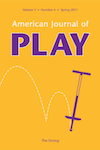Research
The role of self-determination theory and cognitive evaluation theory in home education
Riley, Gina (2016)

Cogent Education (2016), 3: 1163651 .
Less-structured time in children’s daily lives predicts self-directed executive functioning
Barker JE, Semenov AD, Michaelson L, Provan LS, Snyder HR and Munakata Y (2014)

Frontiers in Psychology. 5:593.
Play, ADHD, and the construction of the social brain: should the first class of each day be recess?
Panksepp, Jaak (2008)

American Journal of Play, 1 (1), 55-79.
The Decline of Play and the Rise of Psychopathology in Children and Adolescents
Gray, Peter (2011)

American Journal of Play, 3 (4), 443-463.
Over the past half century, in the United States and other developed nations, children’s free play with other children has declined sharply. Over the same period, anxiety, depression, suicide, feelings of helplessness, and narcissism have increased sharply in children, adolescents, and young adults. This article documents these historical changes and contends that the decline in play has contributed to the rise in the psychopathology of young people. Play functions as the major means by which children (1) develop intrinsic interests and competencies; (2) learn how to make decisions, solve problems, exert self-control, and follow rules; (3) learn to regulate their emotions; (4) make friends and learn to get along with others as equals; and (5) experience joy. Through all of these effects, play promotes mental health.
States of Curiosity Modulate Hippocampus-Dependent Learning via the Dopaminergic Circuit
Gruber, M. Gelman, B. & Ranganath (2014)

Neuron, 84 (2), 486-496.
